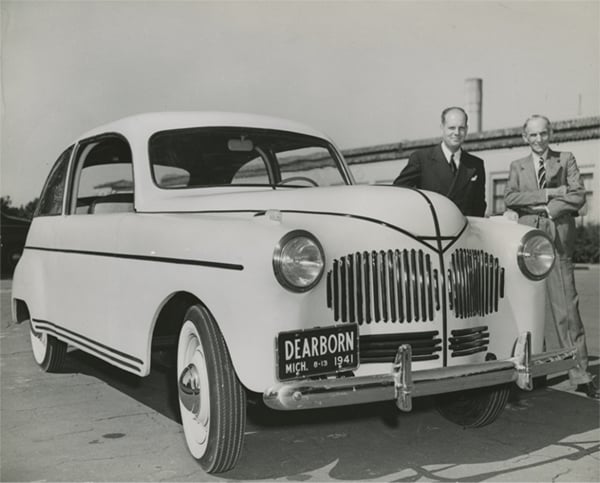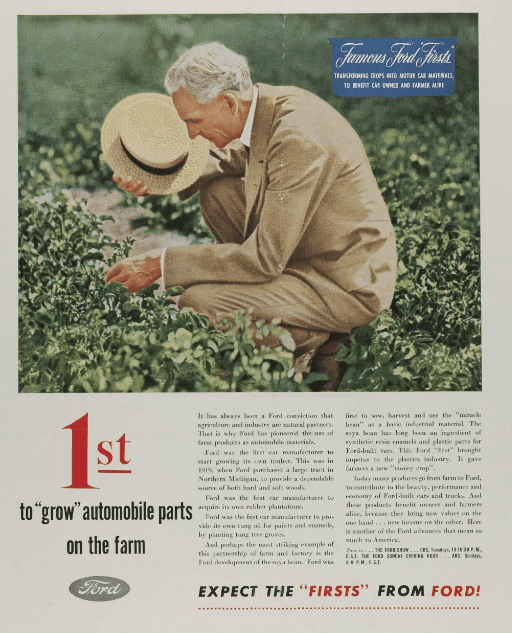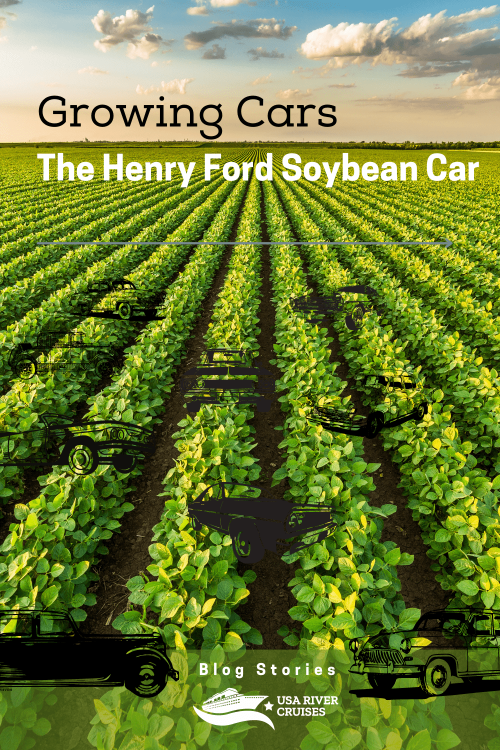
Cars on display at the Henry Ford Museum (photo by Jasperdo/Flickr)
The Henry Ford Museum
Dearborn, Michigan
Can you eat your way to fame? Henry Ford was a man ahead of his time and hungry for innovation. If he was still alive today, he would be at the forefront of tackling climate change head-on. Who else would consider building a car out of soybeans?
Henry Ford would. He was a brilliant man who surrounded himself with fellow out-of-the-box thinkers. He was close friends with Thomas Edison, Harvey Firestone, George Washington Carver, and E.G. Kingston (of Kingston Briquettes fame.). When you surround yourself with innovators, thoughts and “crazy” ideas flow. Those questions “what if?” are kicked around and innovators find ways to make it reality. The conversations between Henry and his staff, or Henry and his friends, must have been fascinating.

The “Soybean Car” was a concept car Henry Ford created. He dreamed of making cars more sustainable and was constantly trying to improve the new industry. It was a plastic-bodied car with a frame still made of tubular steel, but with plastic panels attached The plastic panels contained a mixture of resin, soybean fiber, wheat, and hemp. Henry had a long fascination with the benefits of soybeans, even inviting reporters to a lunch and dinner while at the 1934 World’s Fair in Chicago which featured dozens of soy foods. He served soybean cheese, soybean crackers, soy bread and butter, soy milk, and soy ice cream. Ford was definitely a man ahead of his time.

Mr. Ford always had a great interest in agriculture, having grown up on a farm. Although he had more interest in building machines and taking apart a watch just to see how it worked than working on the farm, Henry did want to find a way to help the farming industry. In what could be a win-win for both the automotive industry and the farmers, he attempted to find a way to minimize the use of metals with alternative, more sustainably sourced materials. The use of less steel also made the car significantly lighter, and thus more fuel efficient. It weighed a full 1,000 pounds lighter than a standard steel car, yet was deemed to be even stronger. It was also designed to run on hemp fuel, another sustainable agricultural crop. Henry had been working on this concept for years – first promoting the idea as early as 1928. He began investing in research regarding the benefits of soybeans in many different areas, including soybean oil to be used in making paint for cars, and ground soybean meal that could be turned into a plastic like resin for automotive parts such as gear shift knobs.
“I Can Grow Automobiles from the Soil”
In 1941, there was a drastic shortage of metal as the country ramped up airplane, jeep, and tank production at the onset of World War II. The war shortages further encouraged Henry Ford to look for alternative ways to build that required less metal. Eventually, though, the growing war effort forced all commercial automotive production to come to a halt, which also placed the research on the Soybean Car on hold indefinitely. By the end of the war, the focus had shifted again, this time towards a massive war recovery effort. The tremendous influx of soldiers returning home from service, many needing a new car and quickly, may have also contributed to the Soybean Car concept fading from the priority list. Henry himself had suffered a series of small strokes beginning in the mid thirties. His decreasing involvement in day-to-day functions at the office may have also taken his personal passion project off the front burner. Henry passed away in 1947, further sealing the fate of the concept car.
It would be another 60+ years before society as a whole could mourn the loss of what might have been. How would the world have been different if the Soybean Car had gone into production? Possibly a stronger agricultural industry. Less battles with the mideast oil-rich countries. No gas shortages in the 1970s. Would the ozone layer be better without fossil fuels being burned in cars and hemp oil instead? How long would it have been if Henry Ford had created a soybean pavement for roads? Or hemp-fused materials for building houses? One man’s creative thinking did change much about the world. If only he could have stuck around a little while longer. The Soybean Car could have been a change for good. Lighter, more fuel efficient, stronger, and sustainable. What’s not to like?

While no Soybean concept car exists today, you can still visit the Henry Ford Museum in Dearborn and explore the amazing life and career of Henry Ford. He was a fascinating, multi-faceted man and there is much to see at the museum – enough to take up an entire day! You can visit Dearborn on an excursion trip while stopping in the Detroit area on the following cruises:
All 5 Great Lakes – Victory II
Chicago to Toronto
- 10 Nights
- May 2, 2025,May 11, 2025,May 20, 2025--
11 more dates available. - From $6,299
- Victory II
- New Itinerary for 2025! Pricing Includes Inaugural Savings of $2000 off Per Stateroom!!
Niagara & the Great Lakes-Viking Octantis
Toronto to Milwaukee
- 7 Nights
- April 22, 2025,April 29, 2025,May 6, 2025--
3 more dates available. - From $6,295
- Viking Octantis
Great Lakes & St. Lawrence Seaway- Victory I
Chicago to Montreal
- 12 Nights
- September 26, 2025,October 7, 2025,October 18, 2025
- From $6,999
- Victory I
Save this story to Pinterest:



